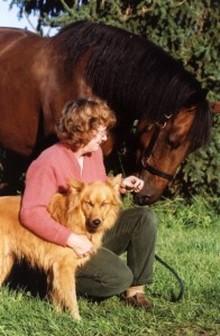Dr. Joyce Harman, a true pioneer in the area of equine insulin resistance and laminitis, will offer a free webinar on the topic Tuesday, June 14 at 8 p.m. EST.

Free horse health webinar by Dr. Harman
Though now not automatic death sentences, metabolic issues make proper horse management much more difficultâespecially during the spring and summer months.
© 2016 by Harmany Equine
Horse owners the world over dread to hear the words âinsulin resistanceâ or âlaminitisâ as they relate to their horses. Though now not automatic death sentences, metabolic issues make proper horse management much more difficultâespecially during the spring and summer months.
âMost horse owners believe their horses are only at risk for grazing-associated laminitis during the spring and early summer when grass growth is most intense,â said integrative and complementary veterinarian Dr. Joyce Harman, founder of Harmany Equine and the Harmany Muzzle. âThe truth is, though, we need to remain vigilant all summer long, as sugar content in the grass changes with the weather.â
All horses, but particularly those with metabolic issues, are susceptible to fructans, a type of sugar, in the grass. If these sugars pass into the hind gut before theyâre digested, they can kick off a process that will cause laminae to fail, leading to a laminitic attack. Metabolic horses also have a difficult time using glucose, or sugar, as fuel and store excess sugar as fat.
âThe horses who have metabolic, laminitic or obesity issues will get progressively worse over the course of the summer,â said Dr. Harman.
Has your horse been diagnosed with insulin resistance or suffered from bouts of laminitis? Do you want to know more? Join internationally known integrative veterinarian Dr. Joyce Harman in this educational *FREE* webinar Tuesday, June 14 at 8 p.m. EST.
ABOUT JOYCE HARMAN
Dr. Joyce Harman opened Harmany Equine Clinic, Ltd in1990, bringing holistic healing to horses from all walks of life, backyard retirees to Olympic competitors. Over the years, Dr. Joyce Harman has observed and adapted to the changing needs the industry. Twenty-plus years ago, no one had heard of Lyme disease or Insulin Resistance, yet today that makes up a large part of her clinical practice.
In 2001, she wrote the first paper in a peer-reviewed journal about the possibility that horses have insulin resistance (IR), and now it is part of our every day conversation. In 2004 she published the first comprehensive book on English saddle fitting since the 1800âs, with the western version of the book following in 2006. To this date, these books are the only books written by an author who is independent from a saddle company, which brings unbiased information to the horse world.
